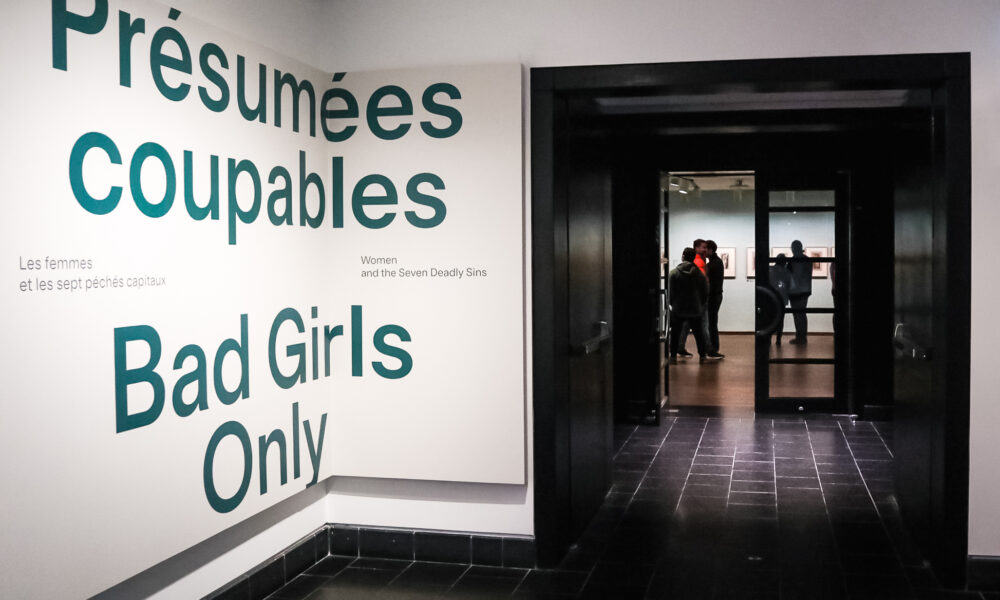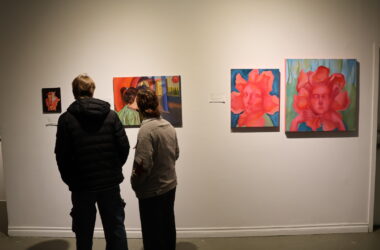Their bodies are cast in stark black ink. Harsh cross-hatching carves out exaggerated forms featuring sagging breasts and bulging stomachs. The slight fingers of one of the women curve around a heart, pulling it to her mouth moments before taking a bite. Another’s hand grasps tightly around the hilt of a sword drawn from the sheath at her hip.
The first room of the Montreal Museum of Fine Art (MMFA)’s new exhibit Bad Girls Only: Women and the Seven Deadly Sins features preparatory drawings by Dutch artist Hendrick Goltzius (1558-1617) coupled with their matching prints created by Goltzius’ stepson, Jacob Matham (1571-1631). The second adjoining space holds another set of prints created by Flemish engraver Hieronymous Wierix (1553-1619). The pieces share a common thread: They all depict women as embodiments of the seven deadly sins.
A TV screen at the end of the exhibit shows modern-day artist Xavier Charbonneau demonstrating the act of printmaking. He takes a pointed tool with a wooden handle called a burin and makes small marks on a copper plate. Once finished, Charbonneau applies a thick black ink to the face of the etched plate with a roller and stamps it onto a piece of paper, the image now permanent.
From gluttony to envy, the prints demonstrate society’s prevailing villainization of women. The earliest pieces in this collection were produced in the 1580s. That women still feel conscious about these ideas 450 years later reveals a terrifying durability surrounding women’s shame. The act of printmaking seems to metaphorically describe the establishment of these ideas in the Western social sphere. Originating as simple sketches, the fuzzy edges of women’s shame are subsequently carved into a metal plate and confirmed throughout time in stark ink.
In addition to the video featuring Montreal artist Charbonneau, the exhibit’s end faces a wall of handwritten cards. Beside this wall sit slots with empty sheets and pencils, providing viewers with the opportunity to make their mark. The cards hold questions relevant to each deadly sin, asking things such as, “What is one thing that made you proud today?” answered by one museum-goer with “Being engaged and enjoying breakfast and art with my family.” Another paper asks, “Describe a food or drink that gives you comfort,” and is met with the answer “Pancakes.” These prompts act as a way for viewers to reframe their positions on shame.
“The empowerment comes from the knowledge of this period, and that internalized shame is not natural and innate; it is culturally and societally produced,” curator Mary-Dailey Desmarais said in an interview with The Tribune.
The distorted bodies of the women in the exhibit are a representation of how society has historically placed women as vessels for degradation. Seeing the artistic process of this is not an ignition of fear but a way of contextualizing such perspectives. Some Dutch man in the 1500s sat down to draw women in their most demeaning form—warnings to women about how their actions make them look to others, thus contributing to a continuing history of slandering women.
But that’s all they are: Drawings. That fact allows for a certain level of freedom. Understanding the fine-scale method it took to bring sketched-out misogyny into permanent ink provides a new sense of power. A pointed carving tool should not make women feel ashamed for eating, getting angry, or having sex.
Facing these works, it can be easy to see yourself in them. All of the things that society tells women not to do stand embodied in front of you. By understanding the process by which these pieces came to be, however, one can see the fabricated nature of their insecurities and start to break free of how society frames them.
‘Bad Girls Only: Women and the Seven Deadly Sins’ is on display at the MMFA until Aug.10 . Tickets are available both online and in person. Free for those aged 25 and under.









